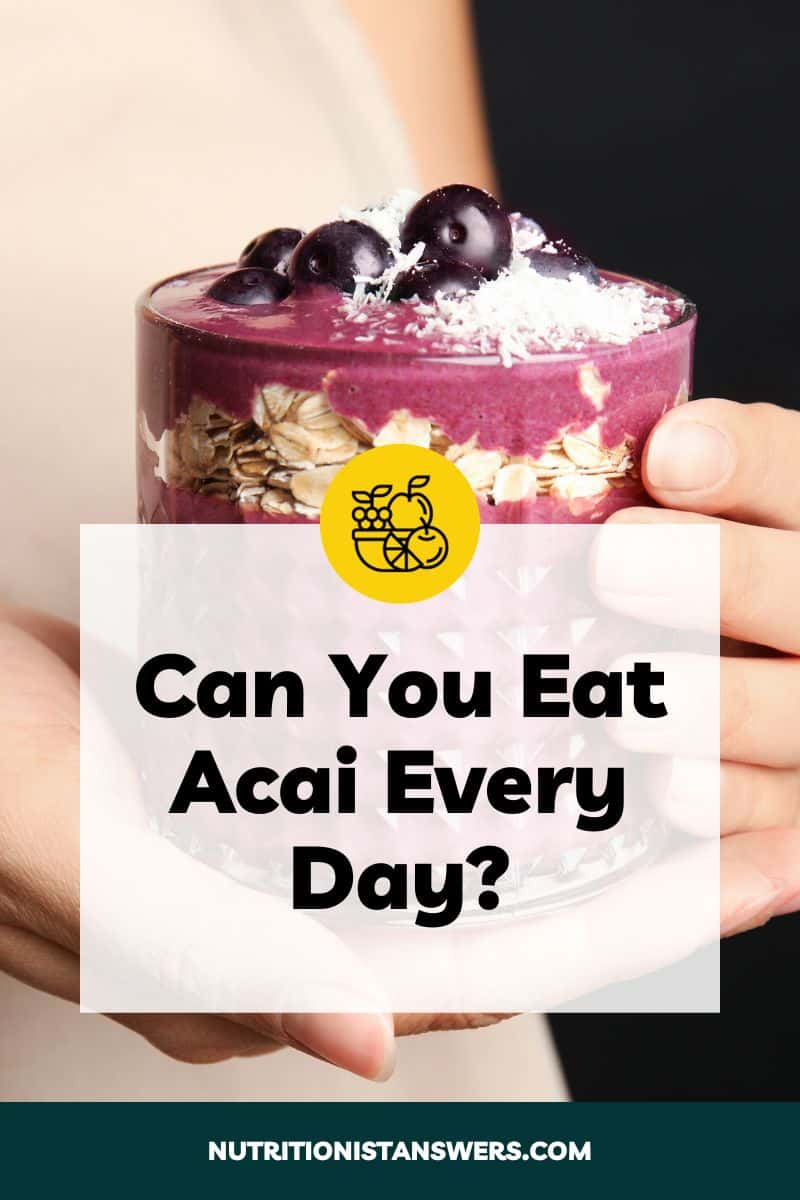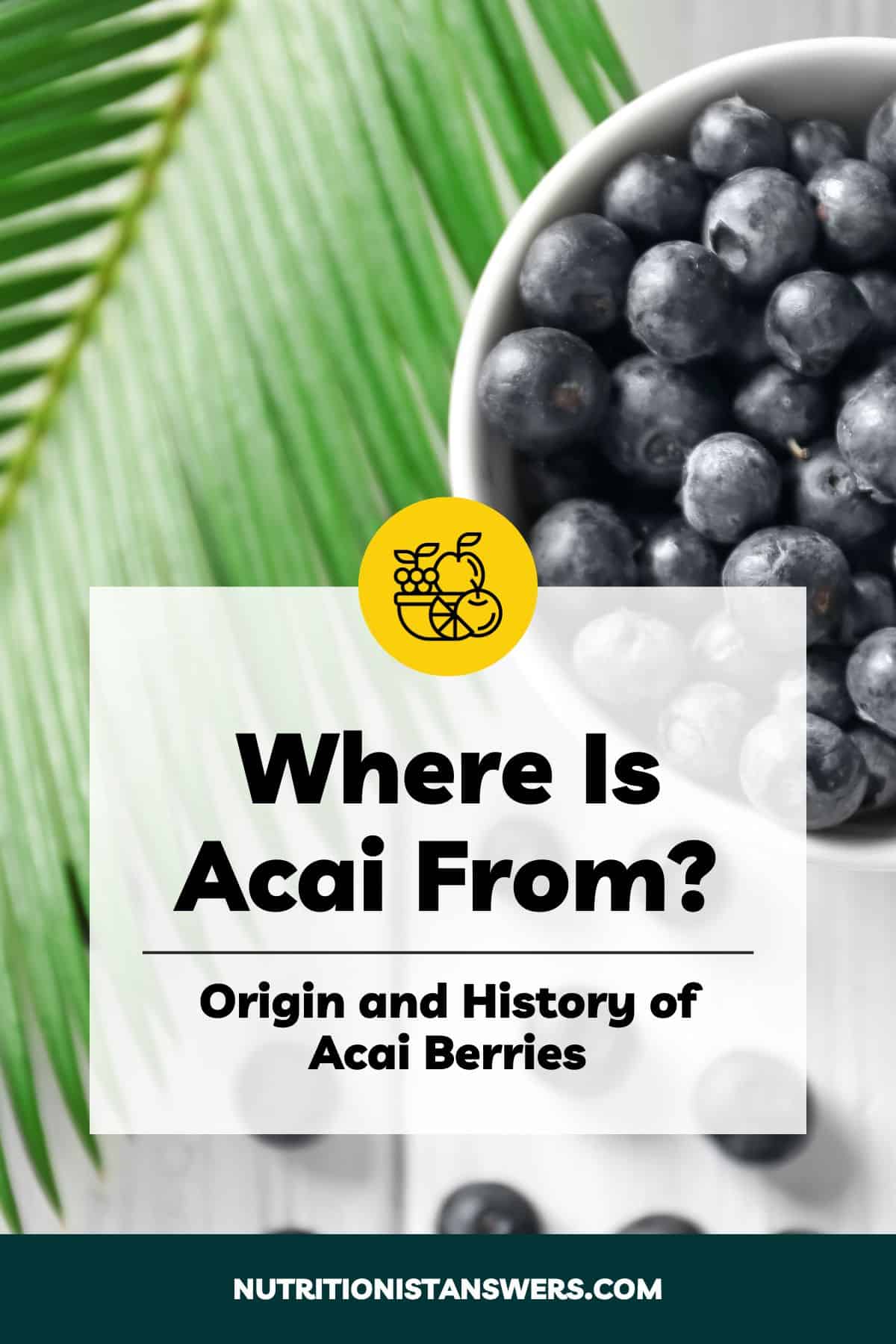Acai has soared in popularity over the past couple of decades, and many people now enjoy acai bowls as a breakfast or snack most days of the week.
But should you really be eating acai every day? Well, maybe — it depends on several factors, such as your budget, health goals, and dietary preferences.
In this article, we’ll go over the pros and cons of daily acai consumption, helping you decide if this popular fruit deserves a regular place in your diet.
Reasons not to eat acai every day
While acai is celebrated for its health benefits, there are some factors that might make you think twice about eating it every day.
1. You have ethical or sustainability concerns
Acai has exploded in popularity over the past couple of decades, leading to concerns about the impact of acai production on the Amazon rainforest (where it grows).
Scientists believe that certain acai harvesting and production practices could lead to a loss of biodiversity in the rainforest and negatively impact the environment (1, 2).
There have also been concerns about the use of child labor to harvest acai, which requires climbing to the top of acai palm trees that can reach heights up to 65 feet (3).
Children are often sent to harvest acai because they weigh less. This makes them less likely to cause the acai palm tree’s slender trunk to snap as they climb.
To combat this, consider buying acai from companies that are Fair Trade certified, a program that prohibits child labor and requires fair wages and environmentally friendly practices.
Want to learn more about the history of acai and how it’s harvested and produced? Check out our article: Where Is Acai From? Origin and History of Acai Berries.
2. You’re on a tight budget
Compared to other fruits, acai is pretty expensive. If you’re trying to save money, it might not be the best choice for everyday use.
Acai is typically sold frozen in packages that cost an average of $6. Every package contains 4 single serving packets, totaling 14 ounces.
This comes out to $1.50 per serving or $0.42 per ounce of frozen acai. That’s around twice the cost of frozen blueberries, which are already one of the more expensive fruit options.
If this is a concern for you, try substituting acai with other fruits, such as blackberries or blueberries. For more substitution tips, take a look at our article: What Can I Substitute for Acai?
3. You’re trying to cut back on added sugars
Acai bowls are the most popular way to use acai, and unfortunately, this tasty treat can be quite high in added sugars, which have been linked to obesity, heart disease, and diabetes (1).
For example, the Dole acai bowl (available in grocery stores) includes 11 grams of added sugars, and an acai bowl from Smoothie King contains a whopping 52 grams (5, 6).
The American Heart Association recommends limiting daily added sugars to no more than 9 teaspoons (36 grams) for men and 6 teaspoons (25 grams) for women (7).
Even homemade acai bowls can exceed the AHA’s recommended limit — don’t forget that “natural” sweeteners like maple syrup and honey also count as added sugars!
To lower the added sugar content of your acai bowl, use pure, unsweetened frozen acai and reduce the amount of sweeteners that you add.
For more tips on creating delicious and nutritious acai bowls, check out our article: Are Acai Bowls Healthy? A Nutritionist’s Perspective.
4. You’re following a low-fat diet
Unlike most fruits, acai is quite high in fat. Because of this, acai may not be the ideal fruit choice for low-fat diets, which typically restrict calories from fat to 30% or less per day (8).
According to the FDA, foods are considered “low-fat” if they contain 3 grams or less of fat per 100-gram serving. With 5 grams of fat per serving, acai is not a low-fat food (9, 10).
This doesn’t mean that you can’t eat acai or other higher fat foods while following a low-fat diet. But eating these foods regularly may make it more difficult to stay within your fat intake goals.
Reasons to eat acai every day
Acai stands out for its unique flavor profile and impressive list of health benefits. We think there are some compelling reasons to include acai in your everyday meal routine.
1. You like the way acai tastes
Acai has a unique flavor – a blend of tart, earthy, and bitter, along with a hint of sweetness. It’s got this berry-meets-chocolate vibe that you won’t get from other fruits.
While it’s important to consider nutrition when making food choices, loving the taste of what we eat makes the whole healthy eating journey a lot more enjoyable and satisfying.
So, if you like acai and want to eat it everyday, we’re not here to tell you otherwise. Your diet should include foods that you not only benefit from nutritionally but also genuinely enjoy.
Want more details about the taste of the different forms of acai, including acai juice and powder? See our article: What Does Acai Taste Like?
2. You’re interested in acai’s health benefits
If you’re drawn to acai for its health benefits, you’re on the right track. These small, dark berries are incredibly rich in antioxidants, as well as fiber, heart-healthy fats, and vitamins A and C (11).
Compared to blueberries, another fruit known for its high antioxidant content, acai berries’ antioxidant capacity is about 85% higher (12, 13).
Antioxidants and other compounds found in acai have been linked with a wide range of health benefits, including reduced cancer risk, lower cholesterol levels, and improved brain health.
Incorporating acai into your daily diet is a fantastic way to harness these health benefits, whether you use it in smoothies, oatmeal bowls, or yogurt parfaits.
To learn more about the science behind acai’s health benefits, take a look at our in-depth article: 7 Nutritional Benefits of Acai.
3. You’re following a ketogenic diet
Unlike many other fruits, acai is naturally very low in carbohydrates and high in fat, making it an excellent keto-friendly fruit option.
A 3.5-ounce (100-gram) serving of frozen, unsweetened acai puree contains 5 grams of carbs, 4 of which are fiber (14, 15, 16). This means acai has only 1 gram of net carbs per serving.
A typical keto diet allows for 20-50 grams of total carbs or less than 25-35 grams of net carbs per day, so a single serving of acai would only account for 2-5% of your daily carb allowance (17).
Unfortunately, traditional acai bowls aren’t very keto-friendly, because they often include high-carb ingredients like juice, yogurt, granola, and sweeteners.
You can make a keto-friendly acai bowl by blending unsweetened acai with canned coconut milk and a little bit of monk fruit for sweetness, then topping it all off with hemp seeds and cocoa nibs.
For more information about how acai can fit into a ketogenic diet, see our article: Is Acai Keto?
The bottom line
It’s perfectly safe to have acai every day, but it’s smart to weigh the benefits against the drawbacks.
Acai is a tasty superfood with plenty of health perks, but it can be expensive and there are concerns about sustainability and potential ethical issues related to its production.
For those on a low-fat diet, acai’s higher fat content could pose a challenge, whereas its low carb content makes it an excellent choice for keto enthusiasts.
Ultimately, the decision to include acai in your daily diet boils down to personal preferences and needs. Whether you choose to indulge in acai regularly or occasionally, the key is to make choices that align with both your health goals and budget.
Amy Richter is a Registered Dietitian Nutritionist based in Missouri. She is an experienced nutrition writer and medical advisor for Healthline and Medical News Today. Amy is passionate about all things food-related and enjoys translating complex science into easy-to-understand articles.





